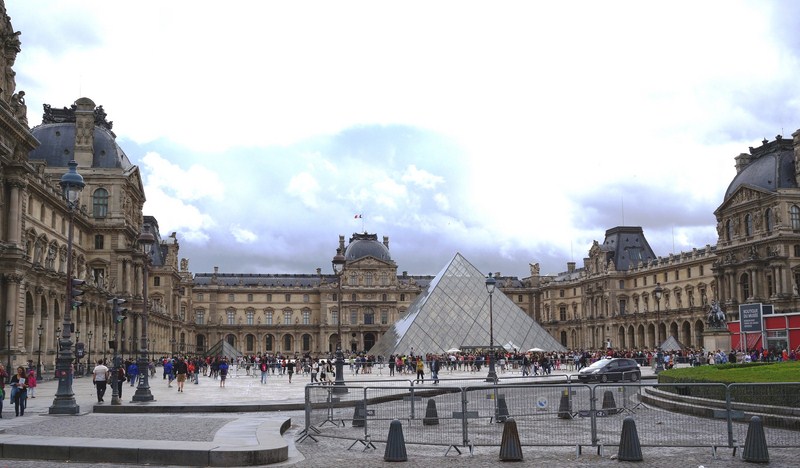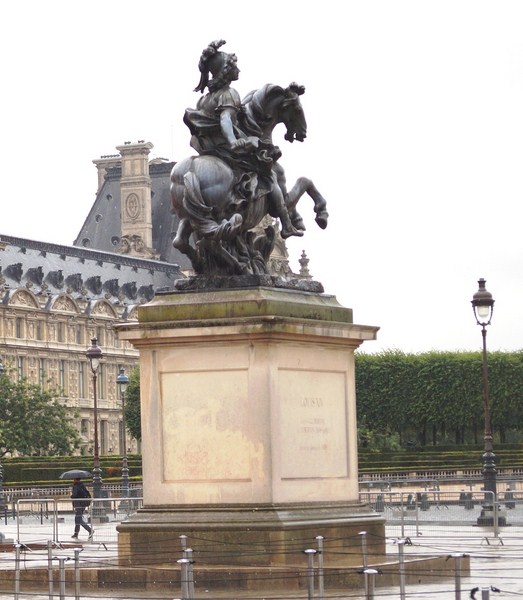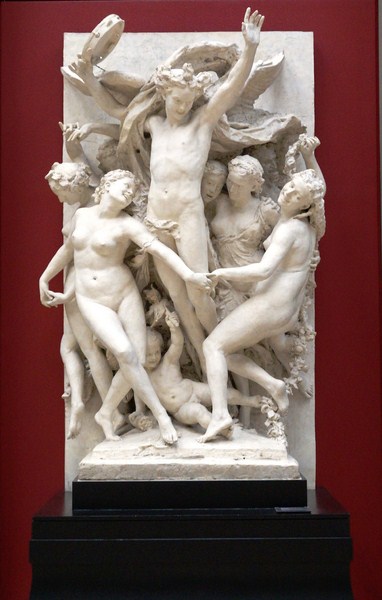The iconic Galerie d’Apollon (Apollo Gallery), home to some of the Louvre’s most precious historical collections, is famous for its high vaulted ceilings with painted decorations. Originally called the ‘Petite Galerie’ of the Louvre, this room was decorated, according to designs by Martin Fréminet for Henri IV of France, by the artists of the Second School of Fontainebleau, most notably Toussaint Dubreuil, Jacob Bunel and his wife Marguerite Bahuche.
Check out “Louvre Museum“
Originally designed as a reception hall, this was the first Royal Gallery for Louis XIV and served as a model for the Hall of Mirrors of the Palace of Versailles. The gallery, left incomplete during the reign of Louis XIV, was filled with paintings by members of the Royal Academy of Painting and Sculpture in the 18th century. With a total surface area of 600 sq. m., it is 61.34 m. long, 15 m. high and was built over 350 years ago and decorated over the course of two centuries.
Here is the historical timeline of this room:
- On February 6, 1661, a fire destroyed much of this small gallery and the young Louis XIV ordered the reconstruction of this part of the Louvre as a reception hall, in line with the fashion of palaces and noble houses at that time.
- Between 1661 and 1663, architectural work was entrusted to architect Louis Le Vau who carried out reconstruction activities. The sculptor François Girardon was responsible for the stucco sculptures.
- From 1663–1677, interior decoration was implemented by Charles Le Brun, the first painter to Louis XIV, who was assigned responsibility by Colbert.
- In 1692, the academy of painting and sculpture was installed at the Louvre which encouraged young artists to finish the room with “reception” or “masterpieces.”
- From 1766–1781, the gallery was completed under the supervision of six academics.
- From 1848–1851, complex restoration work was done by architect Félix Duban, with painting The Race of Apollo by Eugène Delacroix, Aurore by Muller and Triumph of the Earth or Cybele by Joseph Guichard.
- From 1999–2004, restoration activities were carried out by the French restoration service of historical monuments.
As part of the Louvre, this unique masterpiece is both a national and World Heritage Site. A witness to 200 years of art history, it showcases 105 artworks (41 paintings, 36 sculpture groups made up of 118 sculptures and 28 tapestries) along the vaulted ceiling and frescoed walls.
Dozens of French artists contributed to this exceptional interior. Le Brun authored three large paintings, designing a painted and sculpted decor on the theme of the sun and its movement through space (earth, water and continents) and time (zodiac).
The Sun King Louis XIV is glorified by the myth of the sun god Apollo, also evoked by the procession of the Muses. An idyllic vision of the universe in harmony, governed by Apollo, is offered by the overall program. The central section of the ceiling, left blank since Le Brun had worked on the room, was adorned by Eugène Delacroix who thus created the spectacular Apollo Slays the Python.
As of 1663, the stuccoes were made by François Girardon, followed by the Gaspard brothers, Balthasar Marsy, and Thomas Regnaudin, resulting in the majestic, dynamic ensemble we see today.
Since 1861, the gallery has housed Louis XIV’s collection of hardstone vessels in large gilt-wood display tables and vitrines, and those along the walls and under the windows. In 1887, it was joined by the French Crown Jewels, the legacy of centuries of monarchs who successively owned them and had them remounted to their liking. The jewels are presented in custom-made display cases created in the 19th century.
Some of the most precious artworks in the Louvre, this inalienable collection of jewels were initially assembled by Françis I in 1532, grew under Louis XIV and reached its peak under Louis XV. During the French Revolution, the items were dispersed but they were brought back together by Napoleon I. In 1887, however, the French State unfortunately decided to sell almost the entire collection. Luckily, the “Regent,” a white diamond “the size of a Reine Claude plum” (Saint-Simon) was not included in the auction. Acquired by Louis XV, it is the largest of its kind known to exist in Europe.
The remaining 23 pieces of jewels and precious stones held by the Louvre are now displayed in three cases in the center of the gallery and grouped by period: pre-Revolution (including the “Regent” and “Sancy” diamonds, which adorned the crown used at the coronation of King Louis XV in 1722), the First French Empire, the Bourbon Restoration, the July Monarchy and the Second Empire (including what remains of Empress Eugénie’s jewelry sets). Several protective cases designed to hold the items are also presented nearby.
NOTE:
Following the completion of works that began in March 2019, the Galerie d’Apollon reopened. Improvements were made to both the room itself and the presentation of the artworks held within with three new display cases created for the French Crown Jewels (which are now shown together), offering a complete overview of their history.
Several changes were also made in the presentation of Louis XIV’s collection of hardstone vessels. For informational purposes, further examples have been added along with a centerpiece given to Napoleon I by Charles IV of Spain, part of another artwork of royal origin and made of an equally rich variety of materials.
Conservation work was also carried out on the gallery’s décor, returning the room to its former glory. The paintings and stuccoes, along with the tapestries (masterpieces commissioned from the Gobelins manufactory by Félix Duban and put in place in 1852), were dusted and new lighting and an improved security system were installed. A second entrance, making the gallery accessible by both the Rotonde d’Apollon and the Salon Carré, was also opened.
Louvre Museum: 75001 Paris, France. Tel: +33 1 40 20 50 50. Open daily, except Tuesdays and holidays, 9 AM- 6 PM (until 10 PM on Wednesday and Friday evenings).
The Louvre has three entrances: the main entrance at the pyramid, an entrance from the Carrousel du Louvre underground shopping mall, and an entrance at the Porte des Lions (near the western end of the Denon wing).
Admission is free, from October to March, on the first Sunday of every month. Still and video photography is permitted for private, noncommercial use only in the galleries housing the permanent collection.The use of flash or other means of artificial lighting is prohibited. Photography and filming are not permitted in the temporary exhibition galleries.
How To Get There: the Louvre can be reached via Metro lines 1 and 7, station Palais Royal – Musée du Louvre Métro or the Louvre-Rivoli stations. By bus, take No. 21, 24, 27, 39, 48, 68, 69, 72, 81, 95 as well as the touristic Paris l’Open Tour. By car, there is an underground parking reachable by Avenue du Général Lemonier, every day from 7 AM – 11 PM.





















































































